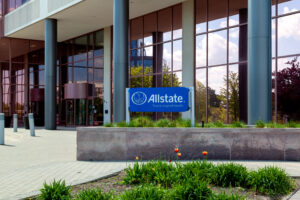
Allstate announces $885M single-month losses, further raises rates
By onCollision Repair | Insurance
Allstate says it sustained $885 million in catastrophe losses in May alone, representing nearly $700 million after tax.
It also said Friday that it implemented auto rate increases averaging 9.3% across 15 locations but did not specify which areas were subjected to price hikes.
The insurance giant said in a press release that its catastrophe losses last month stemmed largely from 12 events, specifically two wind and hail events that accounted for about 70% of its troubles.
For April and May combined, it said its catastrophe losses totaled $1.68 billion pre-tax.
Allstate also sustained catastrophe losses of more than $1 billion during the month of March and said Q1 losses total $1.69 billion. When speaking of that month’s losses, attributed its bleeding bottom line to 10 events, and said it recouped some of its finances by “favorable reserve estimates for prior events.”
Jess Merten, Allstate’s chief financial officer, said rates were increased to help offset its suffering bottom line.
“Allstate continued to implement significant auto insurance rate actions as part of our comprehensive plan to improve profitability,” he said. “Since the beginning of the year, rate increases for Allstate brand auto insurance have resulted in a premium impact of 4.9%, which are expected to raise annualized written premiums by approximately $1.28 billion.”
The insurance giant revealed during a Q4 conference call earlier this year part of its strategy to offset losses attributed to inflation, higher used car prices, and natural events is to modify claim practices.
“Claim practices have been modified to deal with the higher loss cost environment,” said Mario Rizzo, Allstate’s chief financial officer. “For example, we have strategic partnerships with part suppliers and repair facilities to mitigate the cost of repair and use predictive modeling to optimize repair versus total loss decisions and likelihood of injury and attorney representation.”
Meanwhile, GEICO is seeking to secure approval for a nearly 20% rate increase in New Jersey, according to a letter sent to its customers obtained by NJ.com.
“Under the proposed filing, the average liability-only policy will see a rate change of 18.7%,” the letter says. “The average Full Coverage policy [includes comprehensive and collision coverage] will see a rate change of 26.3%.”
In Michigan, drivers will begin paying more insurance fees next month as well when a Michigan Catastrophic Claims Fund increase takes effect. Those with unlimited personal injury protection coverage will pay $122 this year, a 42% increase over last year’s rates.
May’s Consumer Price Index indicates auto insurance has increased 17.1% year-over-year. For context, the increase for all areas excluding food and energy was 5.3% during the same period.
Separately, a J.D. Power study released last week showed that nearly one-third of auto insurance policyholders have experienced rate increases throughout the past year.
However, the study also found that while insurance rates are rising by an average of about 15%, customer satisfaction has dropped year-over-year to its lowest level in 20 years.
Perhaps unsurprisingly, J.D. Power found that the discord between insurers and policyholders was largely driven by cost.
“Overall customer satisfaction with auto insurers has plummeted this year, as insurers and drivers come face to face with the realities of the economy,” said Mark Garrett, director of insurance intelligence at J.D. Power.
“While insurers are caught between a rock and a hard place when it comes to balancing profitability with customer experience, there are several ways they can blunt the negative effects of rising costs, such as proactively offering customers UBI alternatives, clearly signaling and explaining necessary rate increases and consistently delivering on brand promises to instill trust.”
A recent CNBC article highlighted how insurance costs are continuing to rise despite new car prices going down, noting how a number of factors are making auto repairs more expensive, and that those extra costs are being absorbed by rate hikes.
It cited the pandemic as one factor that drove up costs.
“The pandemic has been really disruptive to the auto repair business,” Mark Zandi, chief economist of Moody’s Analytics, told the outlet.
“[Insurers have] really juiced up those premiums. At some point — and I think we’re getting there — people are going to balk.”
Image
Featured image: (JHVEPhoto/iStock)
